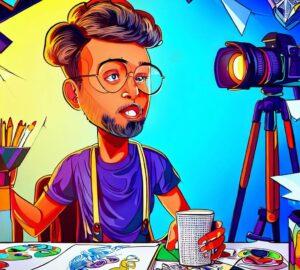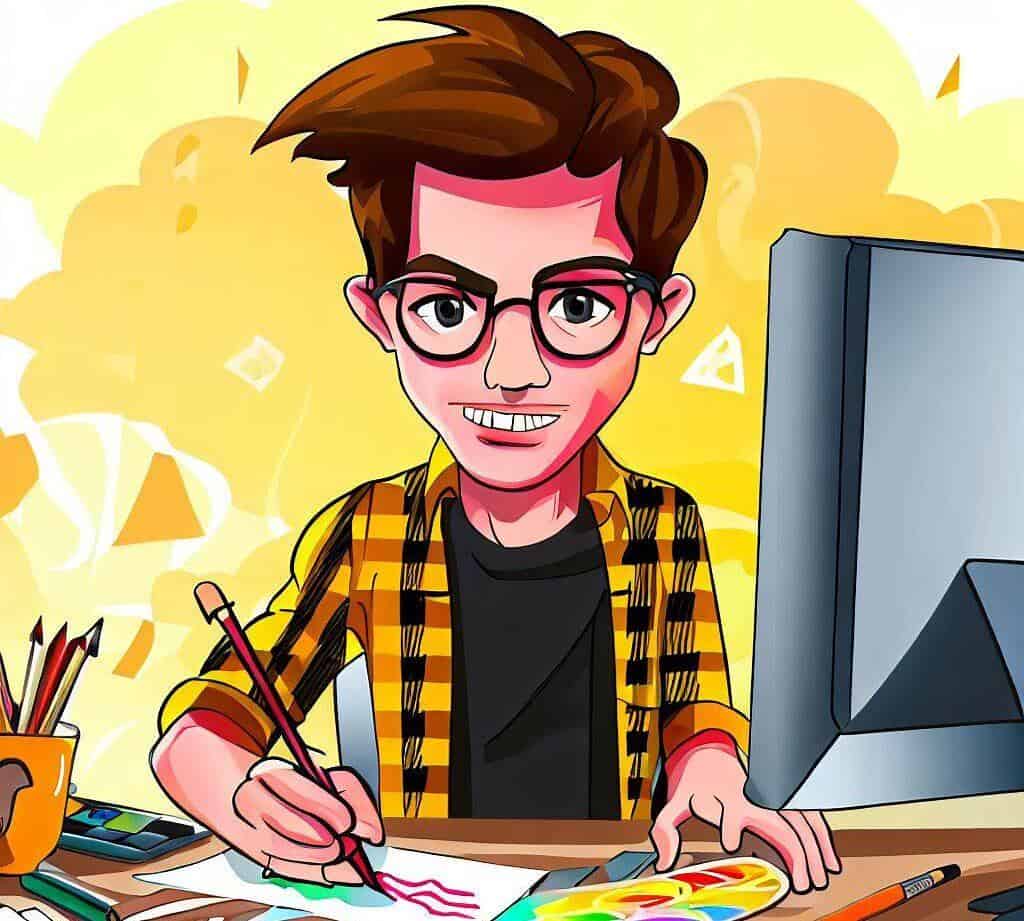In the era of digital communication, graphic design has emerged as a highly valuable skill. Not only is it a creative outlet, but it’s also a marketable ability that can pave the way for numerous career opportunities. In this comprehensive guide, we delve into “Graphic Design Jobs for Teens,” exploring various roles, tools, skills needed, and pathways to start a journey in this vibrant field.
Understanding the Field of Graphic Design
Graphic design is a form of visual communication using typography, images, and color to convey a message or create an effect. As a graphic designer, you may find yourself creating logos for businesses, designing social media posts, or even crafting entire brand identities.
Types of Graphic Design Jobs
There are several areas within graphic design where teens can start their journey:
- Logo Design: Businesses of all sizes need logos to establish their brand identity. If you have a knack for creating eye-catching and meaningful designs, logo designing could be a good fit.
- Social Media Design: With the rise of social media, there’s a constant demand for visually appealing content. Social media design involves creating posts and graphics that grab attention and communicate a message.
- Illustration: If you enjoy drawing, you might consider becoming an illustrator. Illustrators create digital or print drawings for various clients and purposes.
Getting Started with Graphic Design
Teens interested in graphic design jobs can start by learning some essential tools like Adobe Photoshop, Illustrator, and InDesign. There are plenty of online tutorials and courses available on platforms like Udemy or Coursera to help you master these tools.
Developing Essential Skills for Graphic Design
Graphic design is a multi-faceted profession that requires a combination of technical skills and artistic abilities. If you’re interested in pursuing graphic design jobs, here are some key skills you might want to cultivate:
Creativity
Creativity is at the heart of any graphic design job. It’s all about coming up with fresh and innovative ideas that can capture people’s attention and convey a message effectively. Keep your mind open, and always be willing to explore new design trends and concepts.
Proficiency in Design Software
Most graphic design work today is done digitally, which means you’ll need to be proficient in design software. Adobe Creative Suite—including Photoshop, Illustrator, and InDesign—are industry standards. Other useful tools include Sketch, Canva, and Procreate.
Understanding of Color Theory
Color plays a crucial role in how a design is perceived. Understanding color theory—how colors interact, contrast, and complement each other—is essential in creating designs with the desired emotional impact.
Finding Graphic Design Jobs for Teens
Finding graphic design jobs as a teen may seem challenging, but there are many opportunities out there if you know where to look.
Freelancing Platforms
Freelancing platforms such as Upwork and Fiverr are excellent places to start. You can create a profile showcasing your skills and portfolio, and bid on jobs that match your abilities and interests.
Local Businesses
Local businesses often need graphic design work for their marketing materials. Reach out to local businesses in your area and offer your graphic design services. Be prepared to show them examples of your work.
Online Contests
Several websites host online design contests where you can showcase your skills, gain exposure, and even win cash prizes. Websites like 99Designs are worth checking out.
Creating a Portfolio as a Young Graphic Designer
As a graphic designer, your portfolio is a crucial tool. It allows potential clients to see your capabilities and style, and can be the deciding factor in whether you are hired for a project. As a teen, you might not have a lot of professional work to show, but don’t let that discourage you.
Building Your Portfolio
Start by including any design work you’ve done, such as school projects, designs you’ve created for family or friends, or even self-initiated projects. The important thing is to showcase your skills and creativity. Over time, you can replace these initial pieces with professional work as you complete it.
Online Portfolio Platforms
There are many online platforms where you can create a digital portfolio. Some popular ones include Behance and Dribbble. These platforms also provide opportunities to connect with other designers and potential clients.
Benefits of Graphic Design Jobs for Teens

Engaging in graphic design jobs as a teen offers many benefits. Not only can it be a source of income, but it’s also an opportunity to explore a potential career path and develop valuable skills.
Cultivating Creativity and Technical Skills
Graphic design allows you to express your creativity while also developing technical skills. As a designer, you’ll learn how to use professional design software and understand principles of design and color theory.
Building a Professional Network
By working on graphic design projects, you’ll have the chance to connect with clients and other professionals in the field. These connections can be valuable for future job opportunities and for gaining insights about the industry.
Exploring a Potential Career Path
Starting graphic design work as a teen can help you decide if this is a career path you’d like to pursue. Whether you decide to become a full-time designer or use your design skills in another career, the experience will undoubtedly be beneficial.
Continuous Learning in Graphic Design
Graphic design is a dynamic field, with new trends and tools continually emerging. As such, it’s important for aspiring graphic designers to commit to lifelong learning.
Keeping Up with Design Trends
Following popular design blogs, attending webinars, and participating in design forums can help you keep up with the latest trends in the industry. Understanding what’s popular can give your designs a modern and relevant feel, increasing their appeal to clients.
Mastering New Tools and Technologies
Design software and tools are always evolving. Stay updated with the latest tools, and don’t hesitate to learn how to use them. This will not only make your work more efficient but also broaden the range of projects you can take on.
Resources for Aspiring Graphic Designers
There are numerous resources available online that can help you learn graphic design and kickstart your career in the field.
Online Courses
Platforms like Skillshare offer a wealth of graphic design courses, covering everything from the basics to more advanced techniques. Other platforms like Coursera and Udemy also offer comprehensive design courses, many of which are taught by industry professionals.
Design Blogs and Websites
Websites like Smashing Magazine and Creative Bloq offer a wealth of articles, tutorials, and inspiration for designers. Following these can help you improve your skills and stay updated with the latest trends and techniques.
Specialized Fields in Graphic Design
As you explore the world of graphic design, you’ll discover that there are several specialized fields that you can dive into. Each of these fields requires a different set of skills and caters to different interests.
UI/UX Design
User Interface (UI) and User Experience (UX) design are important fields in the design of websites and apps. If you have an interest in technology and a knack for understanding user behavior, this might be a field worth exploring.
Motion Graphics
Motion graphics involve bringing graphics to life with animation. This field is particularly relevant in the world of video production and advertising, where motion graphics can be used to create engaging promotional videos or interactive digital experiences.
Considerations for Teens Starting in Graphic Design

As a teen starting out in graphic design, there are a few key things to consider to ensure a positive and productive experience.
Managing Your Time
As with any job, it’s important to manage your time effectively. Juggling schoolwork with design projects can be challenging, but with good organization skills, it’s entirely possible. It’s crucial to set realistic deadlines and communicate clearly with your clients about your availability.
Setting Fair Rates
Deciding how much to charge for your work can be tricky when you’re just starting. Do some research to understand the market rates for different types of design work. As a beginner, you might charge a bit less than a professional would, but make sure you’re still valuing your time and skills appropriately.
Learning from Feedback
Receiving feedback is a part of any creative job, and it’s an important part of your growth as a designer. Try not to take criticism personally, and instead view it as a learning opportunity. Everyone makes mistakes, especially when they’re just starting out. The important thing is to learn from these mistakes and continuously strive to improve.
Designing for Social Media
With the ever-increasing importance of social media for businesses, the demand for social media graphic design is high. This area of graphic design offers a plethora of opportunities for teen designers to display their creativity and technical prowess.
Social Media Graphics
From creating engaging Instagram posts to designing eye-catching Facebook covers, the scope of social media graphic design is wide. Understanding the specific design requirements and audience preferences of different platforms is key to creating successful social media graphics.
Building a Social Media Presence
As a teen graphic designer, building your own social media presence can also be an excellent way to showcase your work, reach potential clients, and network with other designers. Instagram, with its visual focus, can be a particularly effective platform for designers.
Diving into 3D Design
3D design is an exciting field of graphic design that’s increasingly in demand. It involves creating graphical content in a three-dimensional digital environment – from product designs and architectural visualizations to animated characters for games and movies.
Software for 3D Design
3D design requires knowledge of specific software such as Blender, SketchUp, or AutoCAD. These tools can seem complex at first, but there are numerous online tutorials and courses available that can help you get started.
Opportunities in 3D Design
The application of 3D design is wide-ranging. For instance, you could use it to create 3D artwork for video games, design virtual reality environments, or visualize product designs for businesses. This diversity makes it an exciting and potentially lucrative field for ambitious teen designers.
The Importance of Networking for Young Designers
Networking plays a crucial role in any profession, and graphic design is no exception. Building connections can lead to new opportunities, partnerships, and learning experiences.
Online Design Communities
Joining online design communities is a great way to meet other designers, share your work, and get feedback. Sites like Dribbble and Behance, as well as design-focused groups on social media platforms, are good places to start.
Attending Design Events
Design conferences, meetups, and workshops are excellent places to network and learn. Many events are now held virtually, making them accessible to people all over the world.
Developing Your Personal Brand as a Teen Graphic Designer
As a young graphic designer, developing a personal brand can help you stand out from the competition and attract clients that are a good fit for your style and interests.
Defining Your Style
While it’s important to be versatile, having a recognizable style can make your work more memorable. Try to identify the common threads in the work you enjoy most – whether it’s a certain color palette, a focus on typography, or a particular mood or theme.
Presenting Your Work
How you present your work can also be a part of your personal brand. This includes the design of your portfolio website, how you describe your work, and even how you communicate with clients. Be professional, but don’t be afraid to let your personality shine through.
Finding Inspiration as a Graphic Designer
Inspiration is a crucial part of the creative process. It’s what keeps your work fresh and exciting. But where can you find it? Here are a few ideas.
Exploring Other Designers’ Work
Looking at the work of other designers can be a great source of inspiration. This could be through design blogs, social media, or online design communities. Remember, the goal is not to copy others’ work, but to learn from it and find inspiration for your own unique designs.
Staying Open to the World Around You
Inspiration can come from anywhere. It might be a color scheme you spotted in nature, a pattern on a piece of fabric, or the layout of a magazine page. Keep your eyes open and always be ready to capture ideas when they strike.
Dealing with Creative Blocks
Every creative person experiences creative blocks from time to time. It’s a normal part of the process, but it can be frustrating. Here are some tips for dealing with creative blocks.
Taking a Break
Sometimes, the best thing you can do when you’re feeling stuck is to take a break. Go for a walk, read a book, or do something else you enjoy. Often, ideas will start flowing again when you return to your work with a fresh mind.
Trying a New Technique
Learning a new design technique can help spark your creativity. It might be a new tool in your design software or a design principle you’ve never tried before. Experimenting with something new can help you see your work in a different light.
Seeking Feedback
If you’re feeling stuck on a particular design problem, getting feedback from others can be helpful. They might see solutions or possibilities that you hadn’t considered.
Gaining Real-World Experience as a Teen Graphic Designer
Real-world experience is invaluable for a budding graphic designer. It allows you to apply what you’ve learned, interact with clients, and understand the business side of design.
Freelance Projects
One of the best ways to gain experience as a graphic designer is through freelance work. This could be designing a logo for a local business, creating social media graphics for a non-profit organization, or any other design project that allows you to apply your skills in a real-world context.
Internships
Internships can offer valuable experience and the opportunity to learn from established professionals in the field. While some internships are reserved for college students, there are also opportunities for high school students, especially during the summer months.
Striking a Balance Between Creativity and Practicality
Graphic design is a field where creativity and practicality intersect. While it’s important to push the boundaries of your creativity, it’s also crucial to meet the needs of your clients and adhere to design best practices.
Understanding the Brief
Every design project starts with a brief. It’s essential to fully understand the client’s needs, the target audience, and the project goals before you start designing. This understanding will guide your creative decisions and ensure your designs are not only visually appealing but also effective in achieving their intended purpose.
Adhering to Design Principles
Design principles like balance, contrast, and hierarchy aren’t just arbitrary rules – they’re based on how people perceive and process visual information. By understanding and applying these principles, you can create designs that are not only creative but also clear and effective.
Conclusion: The Future of Graphic Design for Teens
In the ever-evolving world of graphic design, there’s always something new to learn. For teens who are just starting their journey, the potential is limitless. With creativity, persistence, and a willingness to continuously learn and improve, you can turn your passion for design into a rewarding career.
Remember that every graphic designer’s path is unique. Don’t be afraid to experiment, take risks, and find your own voice. Whether you’re designing social media graphics, creating 3D models, or developing a brand’s visual identity, your work as a graphic designer can have a real impact.
The fields of graphic design we’ve discussed in this article are only the beginning. As technology continues to advance, new opportunities in graphic design will continue to emerge. So keep exploring, stay curious, and most importantly, enjoy the process of creating.
Resources for Young Graphic Designers
Online Learning Platforms
There are numerous online platforms that offer high-quality graphic design courses. Here are a few worth checking out:
- Coursera: Offers courses from top universities and organizations worldwide.
- Skillshare: A community-based learning platform with numerous graphic design classes.
- Udemy: Offers thousands of online courses on various subjects including graphic design.
- Lynda: Offers professionally produced video courses on a variety of creative skills, including graphic design.
Design Blogs and Websites
These blogs and websites offer valuable insights, inspiration, and tutorials for graphic designers:
- Behance: An online platform to showcase and discover creative work.
- Dribbble: A social networking platform for digital designers and creatives.
- Design Week: An online magazine covering the design industry.
- Brand New: Provides opinions on corporate and brand identity work.
Design Tools
Here are some essential tools for graphic designers:
- Adobe Photoshop: The most widely used software for photo editing and graphic design.
- Adobe Illustrator: A powerful tool for creating vector graphics.
- Sketch: A digital design toolkit built to help you create your best work.
- Figma: A collaborative interface design tool.
Table of Contents

